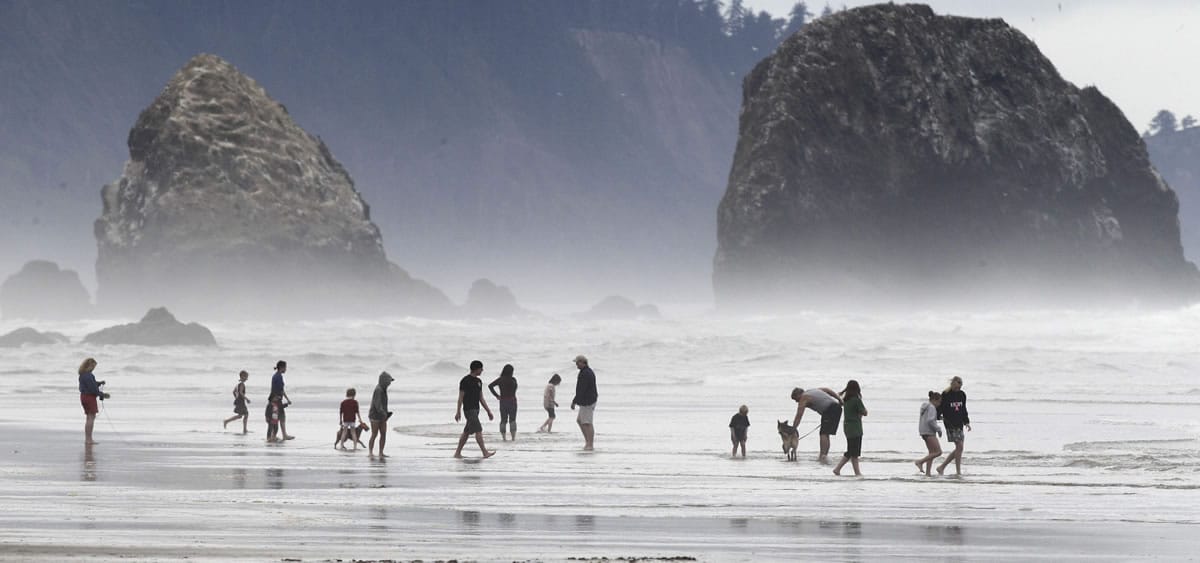CANNON BEACH, Ore. — Haystack Rock is an iconic symbol of Cannon Beach that draws thousands to the small coastal town each year. But members of the Haystack Rock Awareness Program want the public to know the 235-foot-tall rock — protected as an Oregon Islands National Wildlife Refuge and Marine Garden — is more for looking than for touching.
Haystack Rock is what drew Jason Phelps, 35, of Vancouver, B.C., and his girlfriend, Abbey, to Cannon Beach during a trip to Oregon.
“We’ve seen tons of photos and had to stop by to see it for ourselves,” Phelps said. “She’s a big fan of ‘The Goonies,’ too, so that’s a plus.”
Like Phelps, visitors come for that adventure; others are there for a wedding or senior pictures. But a few just can’t resist an urge to reach out and touch, or even climb.
“Sometimes they get tunnel vision,” Program Coordinator Melissa Keyser said. “It’s just not an environment they’ve been in before. They want to check it out.”
“A lot of times it’s an honest mistake,” she added, but she also believes people should know the rules of the places they visit.
Even with the presence of program staff, signage and information, the number of people climbing the rock is high, she added.
From February to September, Haystack Rock Awareness Program staff intercepted more than 1,200 people trying to climb the rock. That was just during beach shifts, each a few hours a day.
Haystack Rock was incorporated as a national wildlife refuge in 1968 and became a marine garden in 1991, one of seven protected intertidal areas along the Oregon coast.
Everything above the high tide line is a part of the protection, meaning it can’t be climbed or walked on, and animals should not be touched, Keyser said. Visitors may take shells, but HRAP staff encourage them not to. The shells can provide habitat for animals.
The designations are meant to guard the animals and plants that call Haystack Rock home.
They also shield Haystack’s visitors, Keyser added. This summer, a “huge rock” fell from the center that could have injured a climber. She noted rock falls occur daily.
The number of climbers intercepted rose from last year, but Keyser noted that the data also reflects increased beach shifts and more volunteers.
There’s a counting device at each beach shift site and those who interact with program staff or volunteers are counted. This year, they had more than 17,000 interactions. That doesn’t include the thousands who don’t stop to talk to Awareness Program members.
Keyser said the majority of people staff and volunteers talk to are interested in doing what they can to protect the rock, as it is a place where “people can experience beauty and animals others are losing.”
Some don’t get what Haystack Rock Awareness Program is doing or want to climb the rock “because they see it as their own,” Keyser added.
Education rather than enforcement is the focus, but program staff have had to call the police a few times this year because a person became extremely upset. Thankfully, those people are “so few and far between,” Keyser added.
Cannon Beach sees people from all over the world, and Portland residents flooded the coast to escape the heat this summer. Haystack Rock is the top Instagrammed location in Oregon.
Program staff and volunteers hand out informational brochures and try to use universal signage at the rock. There are signs posted that say “Do Not Enter” or “Area Beyond This Sign Closed,” but Keyser said they need to consider replacing or cleaning them. Some are covered in barnacles, others get washed out during a storm or king tide.
Signs posted near the rock provide “Keep off” warnings, but do not provide the rationale. However, interpretive signs at beach access points do provide information about the rock’s protected status. Keyser said they are examining a variety of options to expand that message next season, as well. Staff are also planning to extend the program’s season into October, meaning volunteers will be able to monitor visitors for an extra month.
Unfortunately, Keyser noted, even those who live nearby don’t always know the importance of the rock as a protected national wildlife issue.
Sam O’Shields, 24, of Astoria, was a visitor, not a climber. Even so, she said she was unaware of the rock’s status as a protected national wildlife refuge. “But I can understand why it would be,” O’Shields said. “It’s a beautiful area. I don’t know why people wouldn’t want to protect it.”
She, like many visitors, enjoys the diversity of animals, such as anemones, sea stars and the puffins nesting there over the summer.
Keyser said she had encountered students at Astoria High School during a fair who hadn’t heard of the Haystack Rock Awareness Program or even been to the rock. The Awareness Program is working on projects to raise awareness among students and to get the community more involved, including a Facebook page and Twitter feed.
Getting the word out has become a top priority.



